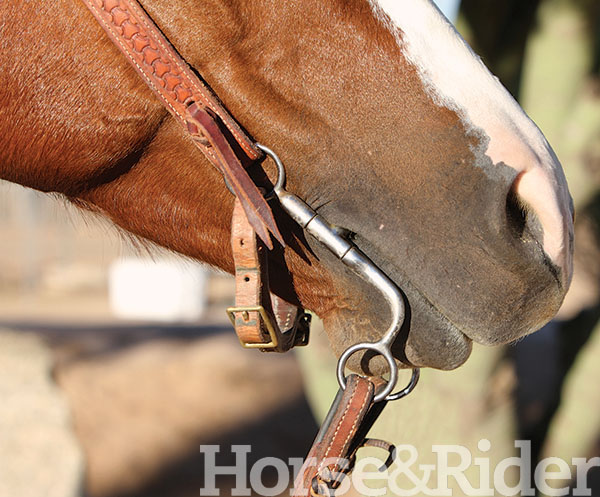Narrow or wide leather or linked chain of various widths—there’s a wide variety of chin straps to choose from, which can make selection puzzling. Here, I’ll help you crack the chin-strap code to pick the right one for your horse and event.

Purpose: The chin strap (or curb strap) works with the bridle to limit how far the purchase of a shanked bit—the upper portion of the cheek that extends from the mouthpiece to the headstall rings—can rise up. It places leverage on the bars of the horse’s mouth with the bars of the bit (the straight piece between the purchase and the shanks of the bit). When the curb strap engages, it causes the bit’s bars to put pressure on the bars of the horse’s mouth. At that point, a well-broke horse will give at his poll and flex and/or stop.
When using a snaffle, a leather chin strap serves a different purpose: It keeps the opposite ring from pulling through the horse’s mouth when direct reining rather than serving a leverage role.
Selection: I advise beginning with a leather curb strap on any horse. Leather has less bite than a flat chain, and gives your horse a chance to have feel for your cues rather than fear. A leather chin strap allows you to use only as much as you need to get a response. If your horse reacts to cues from a leather strap, then that’s all you need. When you’re competing, only leather chin straps are legal on snaffle bits.
Before choosing a flat chain curb, think about your goals and what you’re trying to accomplish. Choosing a flat chain chin strap hinges on how quickly your horse responds to your cues and if you need a quicker response. Slower events like trail or Western riding take a slower cue, so a leather strap might be best. Faster events like reining and roping require a more direct cue with a fast response, making a flat chain a better choice in some cases.
Per most organizations’ rules, chin straps must be at least a half-inch wide. Keep in mind that a leather curb tends to shrink when it gets wet with your horse’s sweat. Choosing a leather chin strap that’s slightly wider than a half-inch means you’ll never be in danger of breaking that rule. If you use a chain, it must be flat—no twisted chain links are allowed.
Adjustment: The chin strap, whether leather or chain, always connects the top rings of the bit, near the corners of the horse’s mouth. Adjust the chin strap so it hangs in the “chin groove,” just behind your horse’s chin. Don’t adjust it too tight (too far up his jaw) or too loosely where it’s just hanging—both mistakes negatively influence the bit’s function.
Most people adjust the curb so that two fingers can fit between it and the horse’s jaw. That’s fine, but a more precise method is to adjust it so that it allows the bit’s shanks to move 2 inches back before the curb engages with the bottom of the horse’s chin groove. This gives the bit a chance to signal the horse before the curb engages. This leeway is important for proper signaling of your horse.
For a snaffle bit, attach the curb strap in front of the reins; not behind. The chin strap’s sole function with a snaffle is to keep the bit’s rings from pulling through the mouth when direct reining. It’s adjusted loosely to allow the snaffle to function properly. n
Al Dunning, Scottsdale, Arizona, has produced world champion horses and riders in multiple disciplines. He’s been a professional trainer for more than 40 years, and his expertise has led him to produce books, DVDs, and his own online mentoring program, Team AD International (teamadinternational.com).






